seats VAUXHALL ZAFIRA 2014 Owner's Manual
[x] Cancel search | Manufacturer: VAUXHALL, Model Year: 2014, Model line: ZAFIRA, Model: VAUXHALL ZAFIRA 2014Pages: 217, PDF Size: 7.85 MB
Page 3 of 217

Introduction.................................... 2
In brief ............................................ 6
Keys, doors and windows ............26
Seats, restraints ........................... 44
Storage ........................................ 67
Instruments and controls .............77
Lighting ...................................... 108
Climate control ........................... 116
Driving and operating .................124
Vehicle care ............................... 151
Service and maintenance ..........191
Technical data ........................... 195
Customer information ................208
Index .......................................... 210Contents
Page 18 of 217
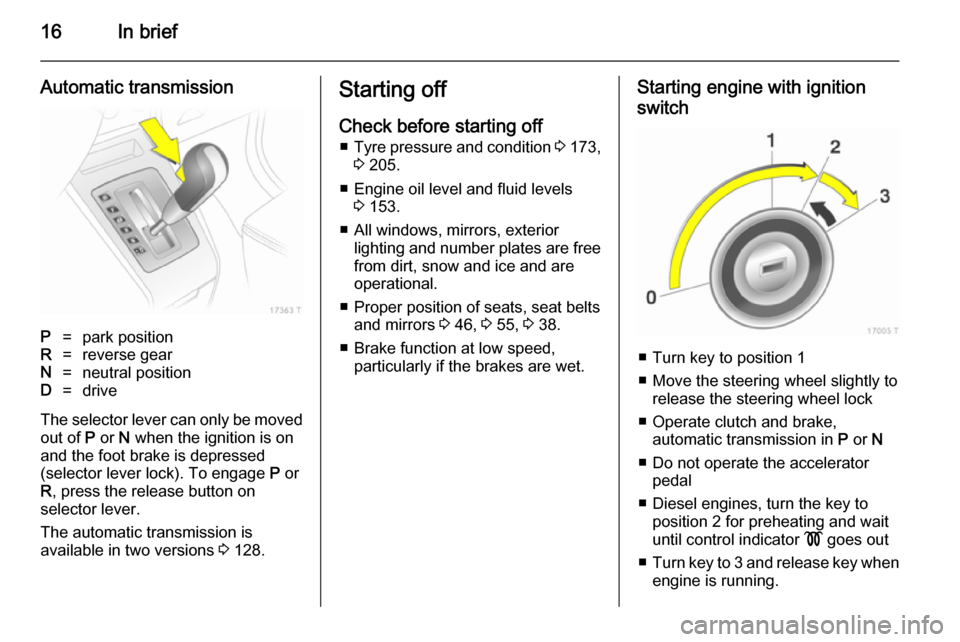
16In brief
Automatic transmissionP=park positionR=reverse gearN=neutral positionD=drive
The selector lever can only be movedout of P or N when the ignition is on
and the foot brake is depressed
(selector lever lock). To engage P or
R , press the release button on
selector lever.
The automatic transmission is
available in two versions 3 128.
Starting off
Check before starting off ■ Tyre pressure and condition 3 173,
3 205.
■ Engine oil level and fluid levels 3 153.
■ All windows, mirrors, exterior lighting and number plates are free
from dirt, snow and ice and are
operational.
■ Proper position of seats, seat belts and mirrors 3 46, 3 55, 3 38.
■ Brake function at low speed, particularly if the brakes are wet.Starting engine with ignition
switch
■ Turn key to position 1
■ Move the steering wheel slightly to release the steering wheel lock
■ Operate clutch and brake, automatic transmission in P or N
■ Do not operate the accelerator pedal
■ Diesel engines, turn the key to position 2 for preheating and wait
until control indicator ! goes out
■ Turn key to 3 and release key when
engine is running.
Page 21 of 217
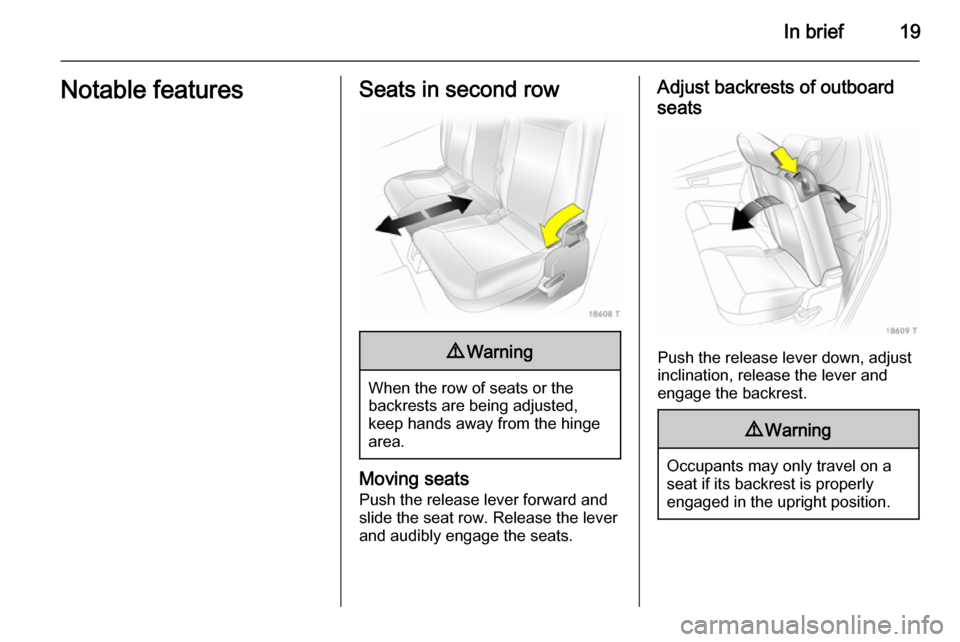
In brief19Notable featuresSeats in second row9Warning
When the row of seats or the
backrests are being adjusted,
keep hands away from the hinge
area.
Moving seats
Push the release lever forward and
slide the seat row. Release the lever
and audibly engage the seats.
Adjust backrests of outboard
seats
Push the release lever down, adjust
inclination, release the lever and
engage the backrest.
9 Warning
Occupants may only travel on a
seat if its backrest is properly
engaged in the upright position.
Page 22 of 217

20In briefSeats in third row9Warning
When the seats are being moved
upright or folded in, keep hands
away from hinge area.
Setting up seats
Remove floor covering 3 70 and
load compartment cover 3 69.
Push the lever forward and slide the
second row of seats forward to the
mark.
Guide the seat belts through the belt
holders and insert the latch plates in the holders.
9 Warning
On version with side rails in load
compartment, follow the
descriptions 3 71.
From the load compartment, pull up
the seat by the handle.
Page 23 of 217

In brief21
Swivel the seat rearward until it is
upright and audibly engages. Support the top of the backrest with your hand.
Preparing belt buckles for use
3 55, Load compartment cover
3 69.
9 Warning
The belt must not be routed
through the belt holder when the seat belt is in use.
Slide the second row of seats to the
required position and engage.
Storing seats
Remove the load compartment cover 3 69.
Push the lever forward and slide the
second row of seats forward to the
mark.
Press the catch to release and slide
the head restraints of the third row all
the way down.
Guide the seat belts through the belt
holders and insert the latch plates in the holders.From the load compartment, press
the button on the top of the backrest
and lower the backrest. Using the
handle on the seat, pull rearwards
and upwards and then swing the seat forwards until it is lowered into the
vehicle floor. Hold the seat by the
handle during the entire procedure.
Retract belt buckle 3 55 and install
floor covering 3 70 and load
compartment cover 3 69.
Slide the second row of seats to the
required position and engage.
Page 24 of 217
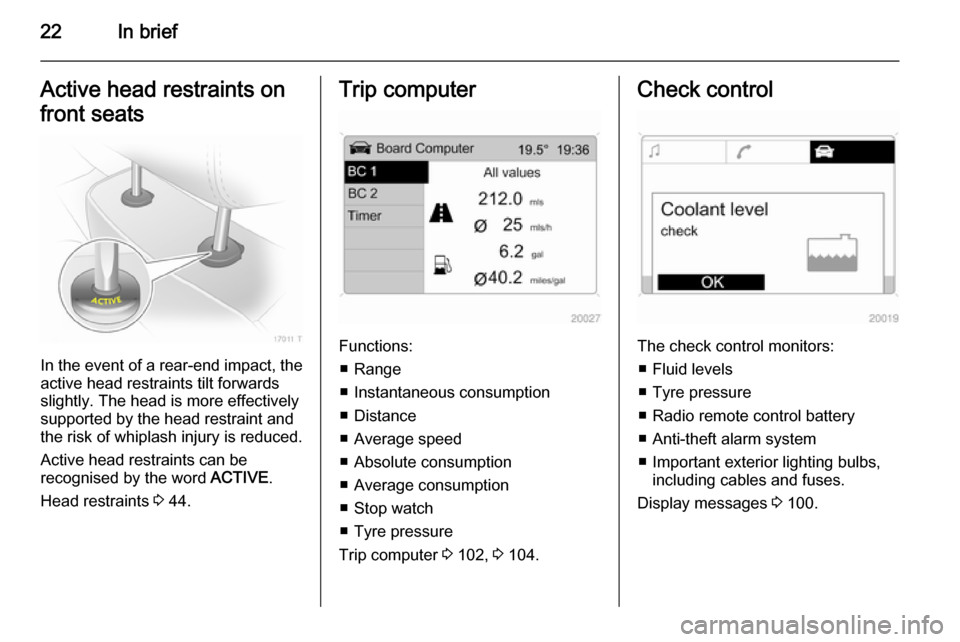
22In briefActive head restraints on
front seats
In the event of a rear-end impact, the active head restraints tilt forwards
slightly. The head is more effectively
supported by the head restraint and
the risk of whiplash injury is reduced.
Active head restraints can be
recognised by the word ACTIVE.
Head restraints 3 44.
Trip computer
Functions:
■ Range
■ Instantaneous consumption
■ Distance
■ Average speed
■ Absolute consumption
■ Average consumption
■ Stop watch
■ Tyre pressure
Trip computer 3 102, 3 104.
Check control
The check control monitors:
■ Fluid levels
■ Tyre pressure
■ Radio remote control battery
■ Anti-theft alarm system
■ Important exterior lighting bulbs, including cables and fuses.
Display messages 3 100.
Page 36 of 217

34Keys, doors and windowsChild locks9Warning
Use the child locks whenever
children are occupying the rear
seats.
Using a key or suitable screwdriver,
turn button on rear door lock to the
horizontal position. The door cannot
be opened from inside.
Doors
Load compartment
Opening
Press the button underneath the
moulding.
9 Danger
Do not drive with the tailgate open
or ajar, e.g. when transporting
bulky objects, since toxic exhaust
gases, which cannot be seen or
smelled, could enter the vehicle.
This can cause unconsciousness
and even death.
Notice
The installation of certain heavy
accessories onto the tailgate may
affect its ability to remain open.
Closing
Use the interior handle.
Do not press the button under the
tailgate moulding while closing as this will unlock the tailgate again.
Page 42 of 217
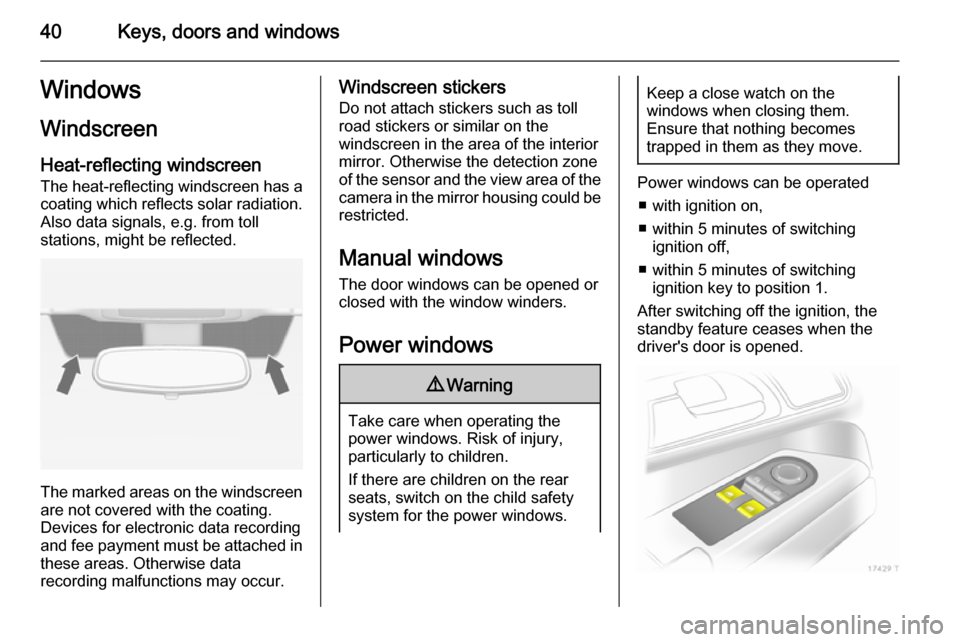
40Keys, doors and windowsWindows
Windscreen
Heat-reflecting windscreen
The heat-reflecting windscreen has a
coating which reflects solar radiation. Also data signals, e.g. from toll
stations, might be reflected.
The marked areas on the windscreen are not covered with the coating.
Devices for electronic data recording
and fee payment must be attached in
these areas. Otherwise data
recording malfunctions may occur.
Windscreen stickers
Do not attach stickers such as toll
road stickers or similar on the
windscreen in the area of the interior
mirror. Otherwise the detection zone
of the sensor and the view area of the camera in the mirror housing could be restricted.
Manual windows The door windows can be opened or
closed with the window winders.
Power windows9 Warning
Take care when operating the
power windows. Risk of injury,
particularly to children.
If there are children on the rear seats, switch on the child safety
system for the power windows.
Keep a close watch on the
windows when closing them.
Ensure that nothing becomes
trapped in them as they move.
Power windows can be operated
■ with ignition on,
■ within 5 minutes of switching ignition off,
■ within 5 minutes of switching ignition key to position 1.
After switching off the ignition, the
standby feature ceases when the
driver's door is opened.
Page 46 of 217

44Seats, restraintsSeats, restraintsHead restraints............................ 44
Front seats ................................... 46
Rear seats ................................... 50
Seat belts ..................................... 54
Airbag system .............................. 58
Child restraints ............................. 61Head restraints
Position9 Warning
Only drive with the head restraint
set to the proper position.
The upper edge of the head restraint
should be at upper head level. If this
is not possible for extremely tall
people, set to highest position, and
set to lowest position for small people.
Adjustment
Head restraints with release button
Press the button, adjust height and
engage.
Page 47 of 217
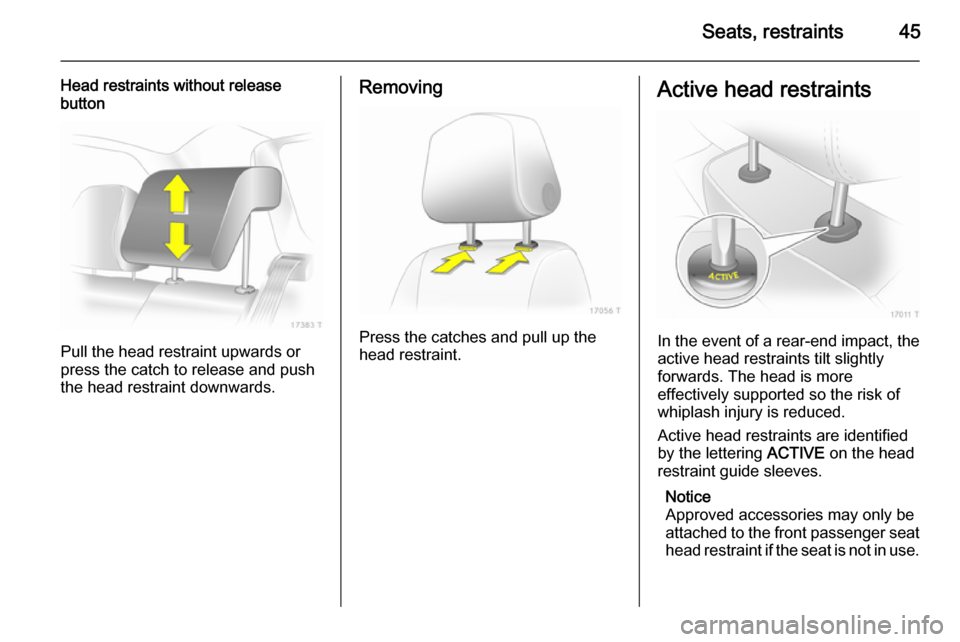
Seats, restraints45
Head restraints without release
button
Pull the head restraint upwards or
press the catch to release and push the head restraint downwards.
Removing
Press the catches and pull up the
head restraint.
Active head restraints
In the event of a rear-end impact, the active head restraints tilt slightly
forwards. The head is more
effectively supported so the risk of
whiplash injury is reduced.
Active head restraints are identified
by the lettering ACTIVE on the head
restraint guide sleeves.
Notice
Approved accessories may only be
attached to the front passenger seat
head restraint if the seat is not in use.